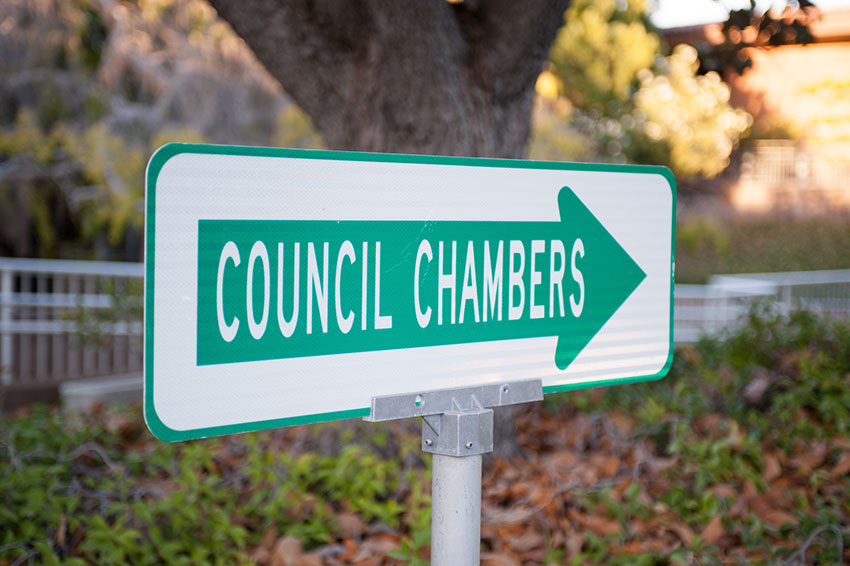After delays, multiple redesigns and repeated public outreach, the Council finally approved the Gateway Crossings project.
The development — set to be located at 1205 Coleman Ave. — has drawn criticism for its design with some saying it has too little retail; others say the increased retail in the redesign will siphon business from the burgeoning effort to revitalize Santa Clara’s downtown.
During its previous discussion in May, the Council opted to press pause on the development to allow the developer, Hunter Properties, to make adjustments in response to public outcry, mostly from the Old Quad Residents Association.
Members of the Old Quad Residents Association again turned out, helping to fill the Council Chambers Tuesday night, saying they were still unhappy with the design.
“We can’t let it be the vision of a developer,” said Adam Thompson, President of the Old Quad Residents Association. “We need it to be our vision.”
At Tuesday’s meeting, the project returned to the Council with some adjustments. Among those adjustments was an increase in the retail space — from 25,000 square feet to 45,000 square feet — increased connectivity and a 35-year lease for the Police Athletic League clubhouse, which Hunter Properties agreed to lease for $1/month.
These adjustments, however, caused the developer to reduce the number of apartments from 1,600 to 1,565 and reduce the hotel space from 162,000 square feet to 152,000 square feet while maintaining 225 rooms.
The development also touts 2.5 acres of park and 10 percent below market rate housing.
Deke Hunter, with Hunter Properties, said the increase in retail space has been specifically modified to accommodate a small grocery store should the market bear it.
Discussion about the development housing a grocery store came up repeatedly at the meeting in May.
Most of the almost 40 public speakers supported the project. However, some said they supported the first phase, which includes the construction of the hotel, but the second phase, with the retail, still needed work.
“Sometimes perfect is the enemy of good,” said Otto Lee, a Santa Clara resident. “This is a good project.”
Council Member Teresa O’Neill said she feared that rejecting the project would communicate to those funding the Bay Area Rapid Transit (BART) extension that Santa Clara is not serious about building transit-oriented hubs.
“It is not exactly what I would like to see,” she said. “But we don’t always get exactly what we want in life.”
The Council unanimously approved the project.
Worker Cooperatives Make Case for City Help
Local business owners, including Council mainstay Kirk Vartan, presented to the Council on how the City can support worker-owned cooperatives in Santa Clara.
Vartan, who co-owns a pizzeria, said worker cooperatives are not a “fringe” and not “a hippy kind of thing.” They are a way to make local businesses more democratic.
Hilary Abell, Co-Founder of Project Equity, said with the massive retirement of Baby Boomers, something she called the “Silver Tsunami,” worker cooperatives are becoming a viable way for cities to maintain legacy businesses.
Worker cooperatives also help address the racial wealth gap and immigrant employment, Abell added.
Carolyn Berke, Co-Founder of worker cooperative Niles Pies, said the worker-cooperative model is a way to handle growth without changing employees. It gets people invested in their community, she added.
“Worker co-ops are creating workers who are more apt to be part of the political establishment,” she said.
The group asked the Council to consider a variety of ways it could support worker cooperatives. Most prominent among that support was to incentivize such business models by providing money — in the form of loans or grants — to help cooperatives get started or stay afloat until they become profitable.
Vartan suggested a $150,000 budget item. Among the other suggestions for support were a resolution in support of cooperatives, conducting outreach and education on cooperatives and market research.
The Council referred the item to the EMC Committee to return to the Council for action at a later date.
Police Chief Vacancy Leaves Council With Decision
Since Santa Clara Police Chief Mike Sellers announced his retirement, the Council will have to decide whether to appoint someone in his place or wait to hold an election.
City Clerk Hosam Haggag said when Sellers vacates his seat as police chief at the beginning of September, the Council will have 30 days to appoint someone to his position. Six of the seven Council members need to approve the appointment, or the Council must hold a special election in March 2020.
Whomever the public elects as Police Chief, would need to seek re-election in the general election in November 2020.
Assistant Police Chief Dan Winter will run the department, as specified in his job description, until the City — either by appointment or election — can find a new police chief.
Contracts
The Council also approved several contracts via the consent calendar.
- A 2-year extension for management services with Orchard Commercial, Inc. for $170,518
- An amendment to a contract with Granicus, LLC to provide website redesign, implementation and support services for an amount not to exceed $663,115
- The award of a $798,000 contract with Anderson Pacific Engineering Construction, Inc. for the replacement of a retention basin pump
- A $694,290 contract for pavement maintenance and rehab road projects with CSG Consultants, Inc. with two contract extensions for $643,500 and $663,300 for subsequent years
The Council’s next regular meeting is Tuesday, July 16 in the Council Chambers at City Hall, 1500 Warburton Ave. in Santa Clara.
